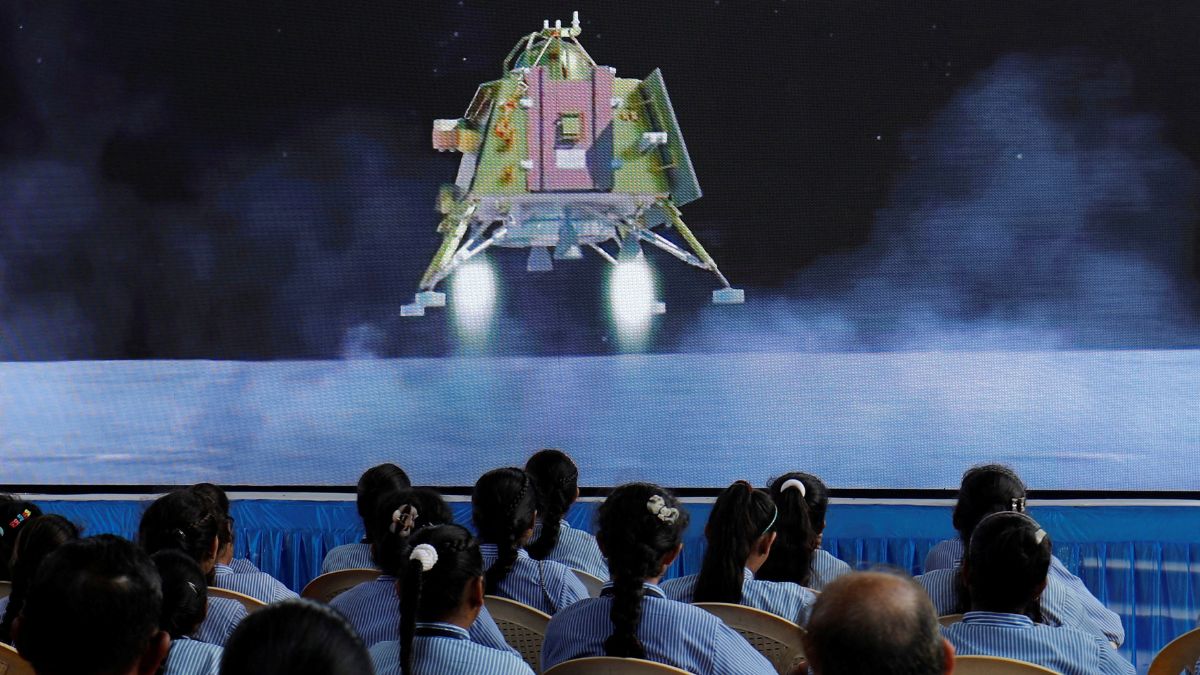India left an indelible mark on the global space sector with the success of its Chandrayaan-3 mission. On August 23, 2023, the Indian Space Research Organisation’s (Isro) lunar spacecraft landed on the Moon’s south pole – a feat no other country has achieved.
Today marks one year to that historic moment. India is celebrating its first National Space Day to commemorate Chandrayaan-3’s landing on the lunar surface. Besides India, only the United States, China and Russia have landed on the Moon.
Isro’s accomplishment garnered global praise for India and its space agency. Despite a slow start, India has become a major space player.
Let’s take a closer look.
Slow beginnings
From carrying rocket cones on bicycles to achieving a feat no other country has, Isro has come a long way.
Vikram Sarabhai, who is hailed as the father of the Indian space programme, launched a small space lab in the garage of his Ahmedabad house. He convinced the Indian government of the significance of a space programme for a developing country like India, according to the Isro.
Starting as the Indian National Committee for Space Research (INCOSPAR), Isro was formally established on August 15, 1969.
Sarabhai supported the idea of “leapfrogging” for space flight, meaning using knowledge gained by other nations apart from skills developed domestically.
Impact Shorts
More ShortsOver five decades later, Isro has become a force to be reckoned with in the space sector.
Speaking to New Scientist magazine, Itty Abraham at Arizona State University said, “What you’re seeing now is the product of four decades of serious investment in this programme that a lot of people dismissed as being inappropriate for a developing country, but turns out to have been a smart decision all along.”
“It’s done a great job of absorbing technologies from different countries and stitching them together to make something that’s uniquely Indian.”
Cost-effective missions
Isro has launched several major projects at low-cost.
Last year’s Chandrayaan-3 mission was one of the country’s most cost-effective space flights with an estimated value of Rs 615 crore. Compared to that, the budgets of Hollywood and Bollywood movies are more. Similarly, Isro’s 2013 Mars Orbiter Mission (MOM), also called Mangalyaan, cost less than Christopher Nolan’s Interstellar.
According to Outlook, Isro has been able to rein in the budgets of its missions by building critical components indigenously and through a lower cost to recruit talent.
As per Business Today, Isro’s ethos of “frugality and pragmatism” was made clear by its head earlier. Isro chairman S Somanath had said in July 2022, “India, especially, is a country where if you like giving it [for] free, it’s very good. You will be building a huge business. But then, of course, there needs to be a business model.”
He is also pushing to make technology affordable. “We have to find ways through which on-ground infrastructure and connectivity are actually delivered to people in millions at an extremely low cost,” the Isro chairman said.
The space agency has also raked in significant revenue by launching missions of several private and international agencies over the last few years. Union minister Jitendra Singh previously informed that Isro earned about Rs 288 crore between 2019 and 2021 through such missions.
Many giant leaps await
Various future missions of Isro revolve around the Moon. India has partnered with Japan for a joint moon mission for which the South Asian country will provide the landing machine.
India is planning to send three astronauts to space. The ambitious Gaganyaan mission is India’s first human spaceflight programme.
The Ernst and Young’s (EY’s) Developing the space ecosystem in India report published in October 2022 predicted the market for space launches will expand in the coming years owing to low-cost launch services, more navigation satellites and higher demand for communication satellites.
“The launch segment is fast becoming a key focus area for startups and small and medium businesses (SMEs) in India to drive the innovation agenda and make use of new revenue opportunities,” the report said.
India’s private space sector worth over $6 billion is also growing. There are at least 140 registered space startups in the country, as per New York Times (NYT).
Abraham gave credit to the Narendra Modi-led government for encouraging the private firms into the space sector. “Where Modi has made a difference is that he has encouraged the private sector to step in in a way that is very unusual for Indian government programmes,” he told New Scientist.
The Modi government inaugurated the Indian National Space Promotion and Authorization Centre (IN-SPACe) to oversee the space activities of the private sector.
Pawan Goenka, chairman of IN-SPACe, wrote for Business Today in February 2024 that the next five years will herald a “new era in the Indian space sector, where the focus is not just on technological advancement but also on global collaboration, on leveraging space for socio-economic benefits and on inclusive growth.”
With inputs from agencies
)